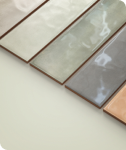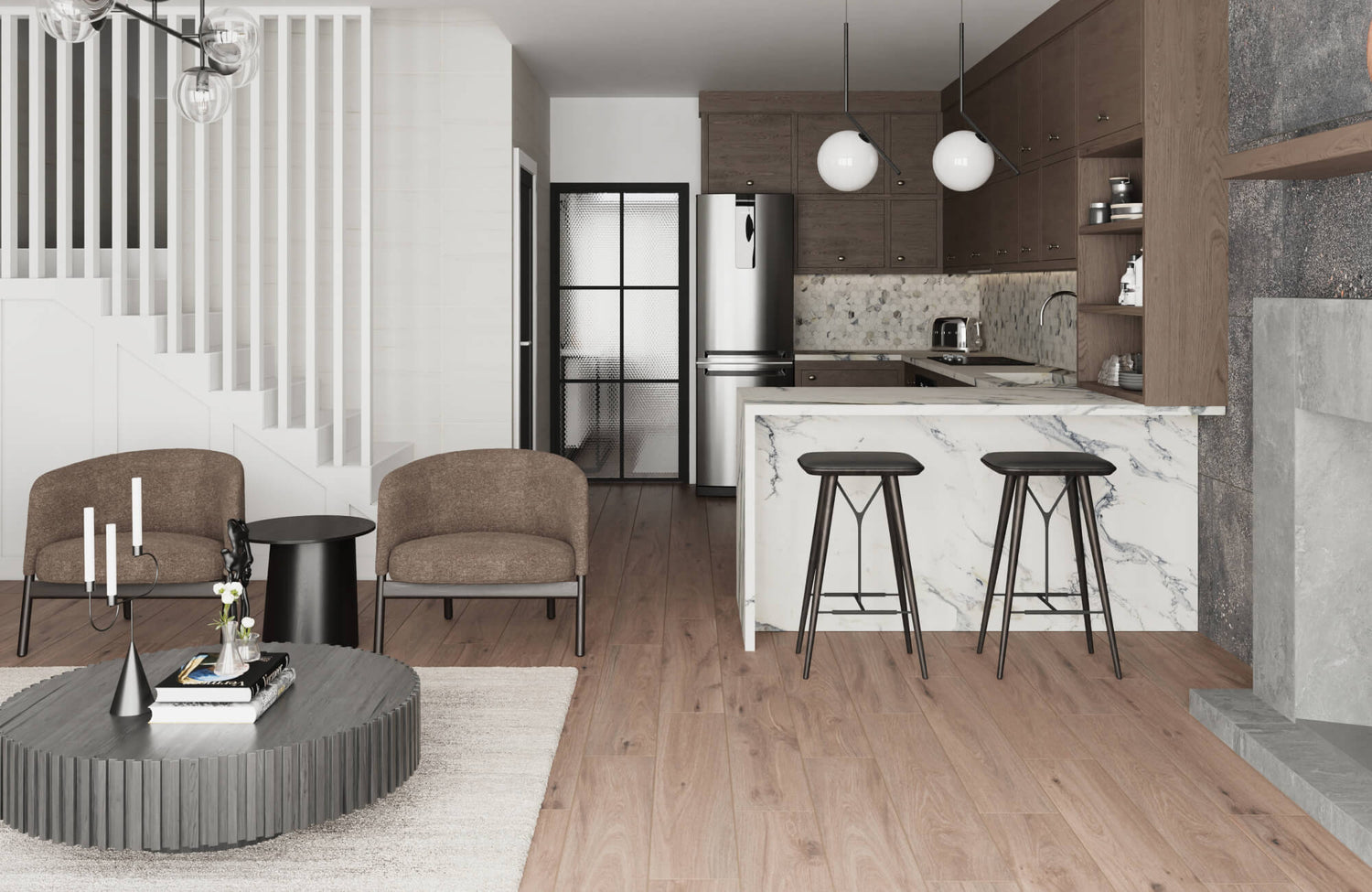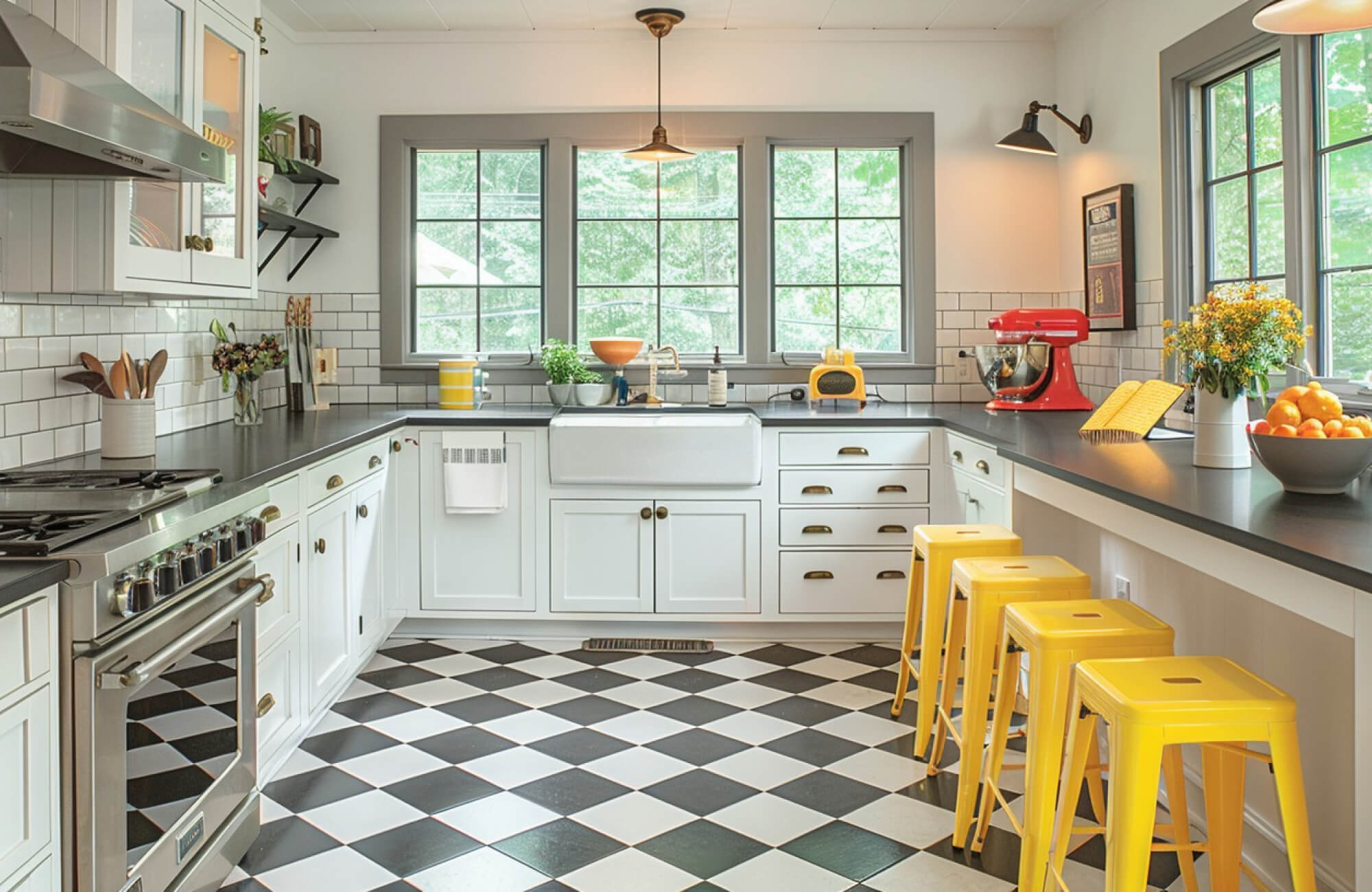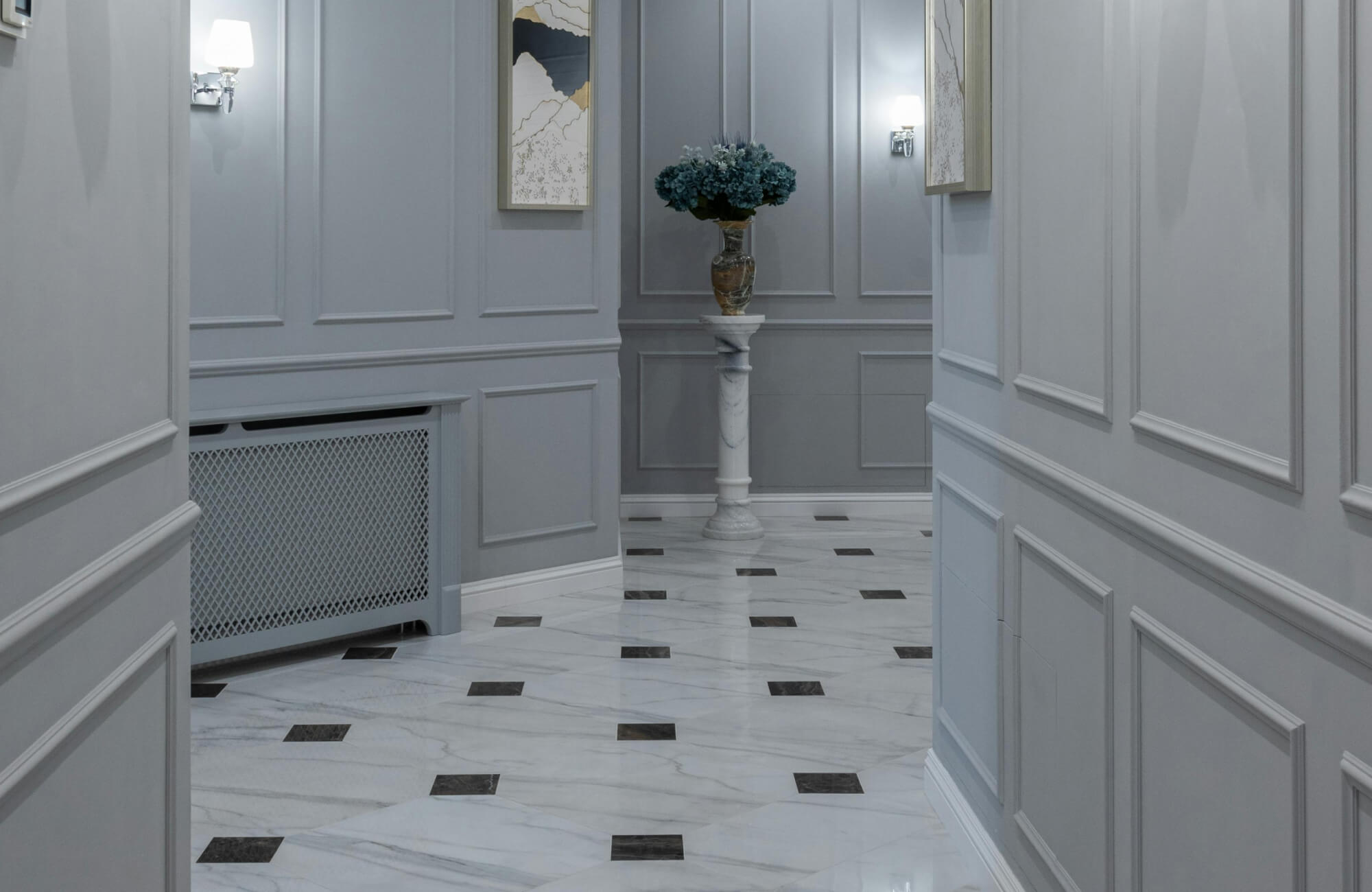Hardwood flooring has long been a symbol of elegance and durability, but in recent years, wood look tile has emerged as a compelling alternative. Offering the authentic appearance of hardwood, these innovative porcelain tiles stand out for their exceptional durability, moisture resistance, and low maintenance, making them a smart choice.
As you consider your flooring options, it's essential to weigh the pros and cons of both hardwood and wood look tile. In this article, we will look at their differences to help determine which option offers the best combination of beauty, durability, and practicality.

What Are Wood Look Tiles and Hardwood Flooring?
Wood look tiles have revolutionized the flooring industry, offering a stunning and durable alternative to traditional hardwood. These innovative tiles are meticulously crafted from porcelain materials, incorporating advanced printing techniques to replicate the intricate details, textures, and colors of real wood. From the warm hues of oak to the rich tones of walnut, wood look tiles provide a versatile and visually appealing flooring solution.
An excellent example of this is the Preston 8x48 Matte Porcelain Tile in Poplar, as shown in the image above. Featuring a soft, light beige tone, this tile captures the subtle, organic beauty of natural wood and delivers the durability and easy maintenance of porcelain. Its wide planks and realistic wood grain pattern also create a bright, welcoming atmosphere, making it perfect for both contemporary and classic interiors.
On the other hand, hardwood flooring has long been a symbol of elegance and sophistication in homes worldwide. Crafted from natural wood species, hardwood floors offer a unique blend of beauty, durability, and warmth. With a wide range of options available, from light-colored maple to dark-toned ebony, hardwood flooring can complement any interior design style.
Despite their similar appearance, wood look tiles and hardwood flooring are made from entirely different materials. Hardwood is a natural product derived from trees, while wood look tiles are manufactured from inorganic materials. This distinction has significant implications for their durability, maintenance requirements, and overall performance.

Performance, Installation, and Application of Wood Look Tile vs. Hardwood
Choosing between wood look tile and hardwood flooring involves more than just picking a style you love. It's important to understand how each material performs under daily wear, how complex the installation process can be, and which rooms are best suited for each option.
Material Strength and Resistance
When it comes to choosing between wood look tile and hardwood flooring, how well each material stands up to everyday challenges plays a major role. From resisting scratches and moisture to handling heat and sunlight, understanding these practical performance factors can help you select the flooring best suited for your space’s demands.
Resistance to Wear and Tear
Wood look tile is significantly more resistant to scratches, dents, and wear compared to hardwood. Heavy use, pet claws, and furniture dragging can easily damage hardwood floors, while wood look tiles remain virtually unscathed.
Water Resistance
One of the most significant advantages of wood look tile is its exceptional water resistance. Unlike hardwood, which can warp or rot when exposed to excessive moisture, wood look tiles are impervious to water damage, making them ideal for bathrooms, kitchens, and other high-humidity areas.
Heat and Sunlight Exposure
Both wood look tiles and hardwood can withstand exposure to heat and sunlight, but wood look tiles often exhibit greater resistance to fading and warping. The dense, non-porous nature of porcelain tiles helps them maintain their color and integrity even under harsh conditions.
Installation Complexity
Installation is another key factor that can impact both your budget and timeline. The complexity of the process, required preparation, and overall installation time differ significantly between wood look tile and hardwood flooring.
Complexity of Hardwood Installation
Installing hardwood floors is a more complex process that requires careful preparation and expertise. The subfloor must be level and free of imperfections, and the hardwood planks need to be acclimated to the room's temperature and humidity for optimal performance. Because of its complexity, professional installation is often recommended to ensure proper alignment, nailing, or gluing, and to avoid potential issues such as warping or cupping.
Ease of Tile Installation
Wood look tile installation is generally less complex and can sometimes be a DIY-friendly project. The subfloor preparation is less critical, and the tiles can often be laid directly over a level surface. This reduces the need for specialized tools or extensive knowledge, making it a more accessible option. However, for optimal results and to ensure the longevity of the installation, it is always recommended to consult with a professional. They can provide expert guidance on proper techniques and help avoid common pitfalls that may arise during installation.
Time and Cost of Installation
The time and cost of installation can vary depending on factors such as the size of the space, the chosen materials, and whether you opt for professional installation. Hardwood flooring typically requires more time and labor, leading to a higher overall cost. Wood look tile installation, on one hand, can be completed more quickly and may be more affordable, especially if you choose to install it yourself.
Application
Not all flooring performs equally well in every room. Moisture levels, usage frequency, and the overall function of a space heavily influence whether wood look tile or hardwood is the better fit. Here’s how to determine which material is best suited for specific areas and how they can even work together beautifully in open-concept layouts.
Best Places for Hardwood
Hardwood flooring is ideally suited for moderately used rooms with low moisture levels. Living rooms, bedrooms, and dining areas are excellent candidates for hardwood, as they typically provide a comfortable and inviting atmosphere. The natural warmth and beauty of hardwood can also add a touch of elegance to these spaces.
Best Places for Wood Look Tile
Wood look tile is a versatile option that excels not just in low-use spaces but also in busy areas with high moisture levels. Kitchens, bathrooms, and entryways are ideal locations for wood look tile. One standout choice is the Preston 8x48 Matte Porcelain Tile in Birch, as depicted in the photo above, which features a soft, light beige tone. Its natural warmth and realistic wood grain make it a perfect choice for creating a bright, inviting kitchen or dining room. Its durability, resistance to water damage, and ease of cleaning also make it a practical and stylish choice for these demanding spaces.
Open Floor Plans and Mixed Materials
In modern open floor plans, combining wood look tile and hardwood can create a visually striking and functional space. For instance, wood look tile can be used in frequently used areas like the kitchen, while hardwood can be installed in more intimate areas such as the living room and bedrooms, creating a cohesive and aesthetically pleasing interior.
To assist in visualizing this combination or to explore the potential of wood look tile in your own space, Edward Martin offers an innovative augmented reality (AR) tool. This technology allows you to preview how different flooring choices, specifically wood look tile, will appear in your space, enhancing your decision-making process with a realistic glimpse of the end result.

Aesthetic Appeal and Design Versatility
Both wood look tile and hardwood flooring offer beautiful design options, but they differ in how they deliver authenticity, versatility, and evolving style trends. Understanding these differences can help you select the perfect flooring to match both your aesthetic goals and your lifestyle needs.
Authenticity vs. Versatility
Hardwood flooring remains revered for its authentic wood feel and texture. The natural variations in grain, knots, and color patterns create a unique and inviting atmosphere. The warmth and softness of hardwood underfoot also contribute to a sense of comfort and coziness that many appreciate. However, advancements in tile design have brought wood look tiles remarkably close to replicating real wood's appearance and character. Because of their high-definition printing techniques and innovative glazing methods, manufacturers can now replicate intricate wood grain details, knots, and subtle color shifts with stunning realism. This progress has made wood look tiles a popular choice for those seeking the aesthetic appeal of hardwood without the higher maintenance demands.
An excellent example of this progress is the Jameson 8x48 Matte Porcelain Tile in Camel, as shown in the picture above. With its soft, sandy beige tones and natural wood grain pattern, it offers the look and warmth of real wood and delivers the durability and low-maintenance benefits of porcelain tile.
Beyond appearance, wood look tiles offer unparalleled design versatility. Although hardwood is naturally limited to the species it is sourced from, wood look tiles can be produced in a wide range of finishes, including distressed, reclaimed, and exotic wood styles. This expanded design palette enables you to create highly personalized spaces that might not be achievable with traditional wood.
Trends and Design Preferences
Hardwood flooring has long been admired for its classic aesthetic, offering both warmth and elegance that never go out of style. Its natural beauty and versatility allow it to complement a wide range of interior design styles, from traditional to contemporary. The authentic character of real wood, along with its ability to age gracefully, also ensures that hardwood continues to be a valued choice for those who appreciate classic, organic materials.
Meanwhile, wood look tile has surged in popularity, especially in modern and contemporary designs. Its durability, low maintenance, and impressive resistance to moisture make it an attractive alternative for busy households. Thanks to advancements in tile technology, manufacturers have achieved highly realistic finishes that closely mimic the grain, color variation, and texture of natural hardwood. This realism has elevated wood look tile from a purely practical option to a sought-after design choice in its own right.
Looking ahead, further innovations in wood look tile are expected. Manufacturers continue to refine printing and glazing techniques to create even more realistic textures and colors, replicating the distinct characteristics of a broader range of hardwood species. Although hardwood will always maintain its classic allure, wood look tile is poised to gain even greater traction for those who prioritize durability, design flexibility, and long-term value.
Cost Considerations and Long-Term Value
When comparing wood look tile and hardwood flooring, it's essential to weigh more than just the upfront cost. Lifetime maintenance expenses and potential resale value also play a major role in determining which option offers the best long-term investment.
Initial Cost
Hardwood flooring typically has a higher initial cost compared to wood look tile. On average, hardwood flooring can range from $8 to $15 per square foot for materials alone, with premium varieties costing even more. Installation adds another $4 to $8 per square foot, depending on the complexity. In comparison, wood look tile usually costs between $3 to $7 per square foot for materials, with installation averaging around $5 to $10 per square foot. This makes wood look tiles generally more affordable upfront.
Lifetime Cost
Although hardwood flooring offers the option to be refinished multiple times, wood look tile proves to be more cost-effective in the long run due to its low maintenance requirements. It does not need refinishing or frequent repairs, which can add significant costs to maintaining hardwood over time. With minimal upkeep and high durability, wood look tile eliminates the need for costly refinishing processes, making it a better long-term investment. In the end, the savings from avoiding ongoing maintenance can far outweigh any initial cost difference between wood look tile and hardwood flooring.
Resale Value
Hardwood flooring is often considered a premium feature that can increase resale value. Potential buyers are generally attracted to the natural beauty, durability, and timeless appeal of hardwood. However, wood look tile is increasingly recognized as a high-quality alternative. Its durability, low maintenance, and modern aesthetic can also contribute to resale value, particularly among buyers seeking stylish, low-upkeep spaces. Choosing the right flooring based on your target market and property type can make a noticeable difference when it comes time to sell.
Sustainability and Environmental Impact
Hardwood flooring can be a sustainable choice if sourced responsibly. Practices such as sustainable forestry ensure that trees are harvested at a rate that allows for natural regeneration, helping preserve forests for future generations. However, deforestation remains a concern, making it crucial to choose hardwood from reputable suppliers who prioritize responsible sourcing.
On the other hand, wood look tiles are generally considered more eco-friendly, especially when manufactured using recycled materials. Their porcelain composition, for instance, is highly durable, which extends product lifespan and reduces the need for frequent replacement. But, it’s worth noting that the manufacturing process for porcelain can be energy-intensive, so evaluating production practices is also an important part of understanding their full environmental impact.
Ultimately, the "greener" choice depends on several factors, including sourcing practices, production methods, and product longevity. For hardwood, selecting options certified by sustainable forestry programs can minimize ecological harm. For wood look tile, opting for tiles made with recycled materials and produced through eco-conscious processes can lessen environmental impact. Additionally, choosing a flooring material that is highly durable and long-lasting can reduce overall waste and resource consumption over time, supporting a more sustainable approach to home improvement.

Safety Considerations and Maintenance
When evaluating wood look tile and hardwood flooring, it’s important to look beyond aesthetics and durability. Health, safety, and ease of maintenance are critical factors that can influence both daily living and long-term satisfaction with your flooring choice. Understanding how each material performs in these areas will help you make a more informed and confident decision.
Safety Considerations
When choosing flooring for your space, safety and health impacts should not be overlooked. Factors like indoor air quality, allergen control, and slip resistance all play a role in creating a safer, healthier living environment. Here’s how hardwood and wood look tile compare across these important considerations.
Hardwood and Air Quality
Natural hardwood flooring can contribute to better indoor air quality. Unlike some wood look tiles, such as those with vinyl that may contain volatile organic compounds (VOCs) in their adhesives or finishes, hardwood is a natural product that emits minimal VOCs. This can create a healthier and more breathable environment, especially for people with allergies or sensitivities.
Tile and Allergen Control
Porcelain wood look tile is an excellent choice for those with allergies or sensitivities. Unlike carpets and even hardwood floors, which can trap dust, dander, and other allergens, porcelain tile surfaces are non-porous and prevent allergens from accumulating. This can help create a cleaner and healthier living space.
Slip Resistance
Although both hardwood and wood look tile can be slippery when wet, hardwood generally offers better grip due to its textured surface. However, with the advancements in tile technology, wood look tiles that come in a textured finish can now provide even better slip resistance. Ultimately, it's important to choose tiles with appropriate slip ratings for busy areas or those with frequent spills.
Maintenance Comparison
When it comes to daily care, wood look tile and hardwood flooring offer very different maintenance experiences. Hardwood flooring requires regular sweeping or vacuuming to remove dirt and debris, along with occasional polishing to maintain its finish. It is also sensitive to moisture, meaning spills should be wiped up promptly, and cleaning products must be specially formulated for wood to avoid damage.
Wood look tile, by contrast, is exceptionally easy to maintain. Its non-porous surface allows for quick cleaning with simple sweeping and mopping using a manufacturer-approved mild detergent. Unlike hardwood, it does not require refinishing or special cleaners, making it ideal for those seeking a low-maintenance flooring option. With basic routine care, wood look tile can retain its appearance for many years without additional treatments or repairs.
Deciding if Wood Look Tile or Hardwood Flooring Is Right for You
In the battle between wood look tile and hardwood flooring, the "better" choice ultimately depends on your individual priorities and circumstances. Wood look tile excels in durability, maintenance, and versatility, making it a practical choice for busy areas and moisture-prone environments. Meanwhile, hardwood flooring offers a timeless beauty, natural warmth, and potential for increased resale value.
To decide which is best for your space, consider your lifestyle, budget, and the specific needs of each room. By evaluating these factors, you can select the flooring that complements your space and aligns with your long-term plans. For further assistance or personalized advice, contact us to provide expert guidance and help you select the ideal flooring solution for your space!









